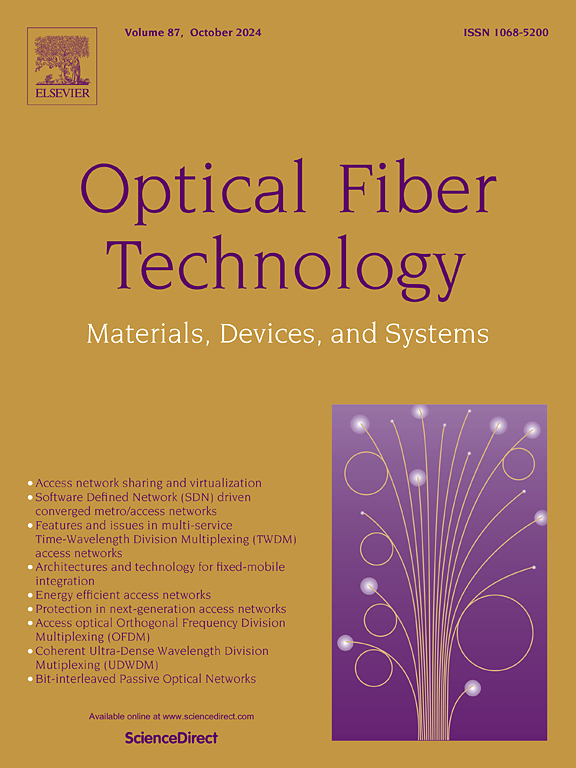下一代光网络:集成自适应FEC速率LDPC和高阶概率星座形成
IF 2.6
3区 计算机科学
Q2 ENGINEERING, ELECTRICAL & ELECTRONIC
引用次数: 0
摘要
为了满足下一代通信需求,我们提出了一个新的框架来提高信道容量。该框架结合了前向纠错(FEC)率低密度奇偶校验(LDPC)编码和高级增强功能,如高阶调制和概率星座整形(PCS)。我们的方法针对6G和未来技术不断增长的需求。我们使用64-QAM和256-QAM信号检查了固定块长度为64,800的LDPC码率为5/ 6,8 /9和9/10。该系统具有大约150 Gbaud的符号率,能够为两种调制方案产生LDPC编码信号。在光通道上的性能分析表明,即使有较高线宽的激光源的相位噪声,系统也具有弹性。我们确定了优化的光信噪比(OSNR),以满足加性高斯白噪声(AWGN)信道中10-6的误码率(BER)目标,确保了强大的性能。该研究还探讨了64-QAM和256-QAM信号的互信息(MI),广义互信息(GMI)和归一化GMI (NGMI)等信息理论度量。我们比较了PCS与均匀分布的QAM信号的性能,提供了一个全面的评估。通过详细的实验和分析,本研究为提出的系统的实用性和性能提供了有价值的见解,标志着未来网络复杂光通信系统的重大进步。本文章由计算机程序翻译,如有差异,请以英文原文为准。
Next-generation optical networks: Integrating adaptive FEC rate LDPC and higher order probabilistic constellation shaping
To address the next-generation communication needs, we present a new framework to improve channel capacity. This framework combines forward error correction (FEC) rate Low-Density Parity-Check (LDPC) coding with advanced enhancements like higher-order modulation and Probabilistic Constellation Shaping (PCS). Our method targets the growing demands of 6G and future technologies. We examine LDPC code rates of 5/6, 8/9, and 9/10 for a fixed block length of 64,800 using 64-QAM and 256-QAM signals. The system features approximate 150 Gbaud symbol rate, capable of generating LDPC coded signals for both modulation schemes. Performance analysis over an optical channel shows the system’s resilience, even with phase noise from a laser source with a higher linewidth. We determine an optimized Optical Signal to Noise Ratio (OSNR) to meet Bit Error Rate (BER) targets of 10-6 in an Additive White Gaussian Noise (AWGN) channel, ensuring strong performance. The study also explores information-theoretic metrics like Mutual Information (MI), Generalized Mutual Information (GMI), and Normalized GMI (NGMI) for both 64-QAM and 256-QAM signals. We compare the performance of PCS with uniformly distributed QAM signals, providing a thorough evaluation. Through detailed experimentation and analysis, this research offers valuable insights into the practicality and performance of the proposed system, marking a significant advancement in sophisticated optical communication systems for future networks.
求助全文
通过发布文献求助,成功后即可免费获取论文全文。
去求助
来源期刊

Optical Fiber Technology
工程技术-电信学
CiteScore
4.80
自引率
11.10%
发文量
327
审稿时长
63 days
期刊介绍:
Innovations in optical fiber technology are revolutionizing world communications. Newly developed fiber amplifiers allow for direct transmission of high-speed signals over transcontinental distances without the need for electronic regeneration. Optical fibers find new applications in data processing. The impact of fiber materials, devices, and systems on communications in the coming decades will create an abundance of primary literature and the need for up-to-date reviews.
Optical Fiber Technology: Materials, Devices, and Systems is a new cutting-edge journal designed to fill a need in this rapidly evolving field for speedy publication of regular length papers. Both theoretical and experimental papers on fiber materials, devices, and system performance evaluation and measurements are eligible, with emphasis on practical applications.
 求助内容:
求助内容: 应助结果提醒方式:
应助结果提醒方式:


